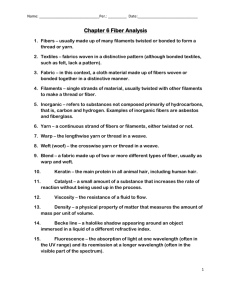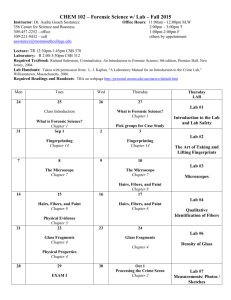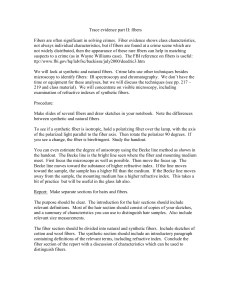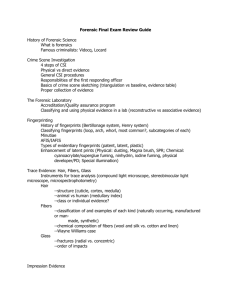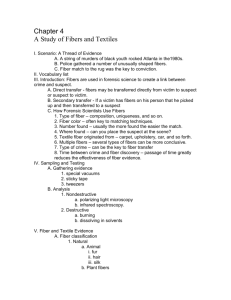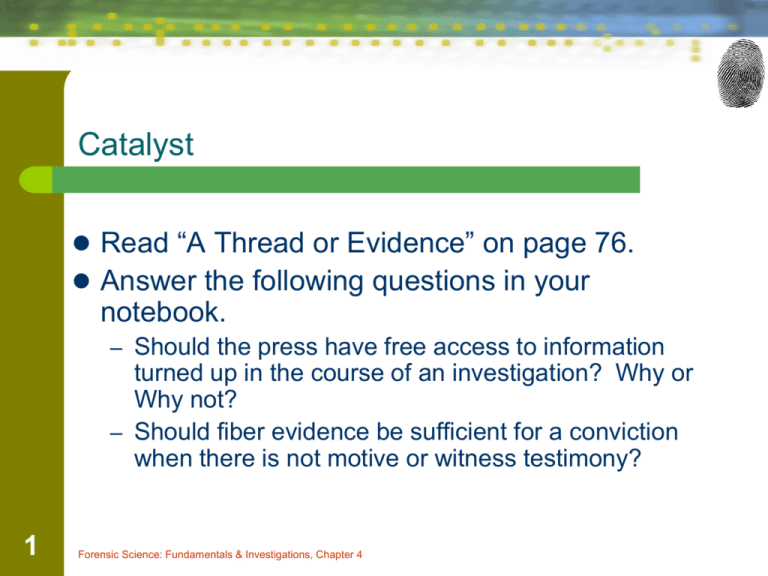
Catalyst
Read “A Thread or Evidence” on page 76.
Answer the following questions in your
notebook.
– Should the press have free access to information
turned up in the course of an investigation? Why or
Why not?
– Should fiber evidence be sufficient for a conviction
when there is not motive or witness testimony?
1
Forensic Science: Fundamentals & Investigations, Chapter 4
Chapter 4 A Study of
Fibers and Textiles
By the end of this chapter you will be able to:
identify and describe common weave patterns
of textile samples
compare and contrast various types of fibers
through physical and chemical analysis
describe principle characteristics used to
identify common fibers
apply forensic science techniques to analyze
fibers
All Rights Reserved South-Western / Cengage Learning © 2009
2
Forensic Science: Fundamentals & Investigations, Chapter 4
Introduction and How Forensic
Scientists Use Fibers
How are fibers used in Forensic Science?
– To create a link between crime and suspect.
Fibers are not specific to an individual, but…
– often fall off and are picked up during activities and
go unnoticed
– may provide police with evidence even if a suspect
wears gloves
Fibers are a form of trace evidence
– Where can fibers originate?
3
Forensic Science: Fundamentals & Investigations, Chapter 4
Introduction and How Forensic
Scientists Use Fibers
Fiber Transfer
Direct Transfer
Secondary Transfer
Transfer occurs from Transfer occurs from
victim to suspect or a source to the
suspect to victim
victim then to the
suspect
Give an example of
this.
4
Forensic Science: Fundamentals & Investigations, Chapter 4
Give an example of
this.
MiniActivity: Fiber Transfer
Procedures: Press the sleeves (or cuffs) or
your clothing together. Examine your clothes
for fiber transfer using masking tape and a
hand lens.
Questions:
–
–
5
Can fibers from one sleeve be detected on the
other?
Do masking tape and hand lenses aid the
investigation? How?
Forensic Science: Fundamentals & Investigations, Chapter 4
Introduction and How Forensic
Scientists Use Fibers
THINK: Why are dead bodies no longer
shrouded (or covered) in cotton sheets? Why
are plastic body bags used instead?
6
Forensic Science: Fundamentals & Investigations, Chapter 4
Introduction and How Forensic
Scientists Use Fibers
In an investigation, collection of fibers within
24 hours is critical.
–
Why?
Fiber evaluation can show such things as the
type of fiber, its color, the possibility of
violence, location of suspects, and point of
origin.
7
Forensic Science: Fundamentals & Investigations, Chapter 4
Introduction and How Forensic
Scientists Use Fibers
Questions a forensic scientist will consider
when examining fiber evidence:
–
–
–
–
–
–
–
–
8
What type of fiber is it?
What is the fibers color?
Number of fibers found?
Where was the fiber found?
Textile the fiber originated from?
Are there multiple fibers transferred?
What type of crime was committed?
Time between crime and discovery of fibers?
Forensic Science: Fundamentals & Investigations, Chapter 4
Sampling and Testing
How are fibers collected?
–
–
–
–
–
9
Special Vacuums
Sticky Tape
Forceps (tweezers)
Black Lights
Magnifying Glasses
Forensic Science: Fundamentals & Investigations, Chapter 4
Sampling and Testing
Weaving spun fibers (yarns) together produces
clothing and many textiles.
Shedding from an article of clothing or a textile is
the most common form of fiber transfer.
Natural fibers require only an ordinary
microscope to find characteristic shapes and
markings.
Infrared spectroscopy can reveal something of
the chemical structure of other fibers that,
otherwise, may look very much alike.
10
Forensic Science: Fundamentals & Investigations, Chapter 4
Sampling
and Testing
If a large quantity of fibers is found, some
can be subjected to destructive tests such
as burning them in a flame (see analysis
key above) or dissolving them in various
liquids.
Crimes can be solved in this way by
comparing fibers found on different
suspects with those found at the crime
scene.
11
Forensic Science: Fundamentals & Investigations, Chapter 4
Homework
Read Pages 77-80, create a Venn Diagram
comparing hair evidence to fiber evidence
in your notebook.
This will be checked for completion
tomorrow.
12
Forensic Science: Fundamentals & Investigations, Chapter 4
Fiber and Textile Evidence
The most common fiber transfer is
shedding of textiles (clothing, carpets,
upholstery)
Fibers can be classified as:
– Natural Fibers (come from animals, plants, and
minerals minded from the ground)
– Synthetic Fibers (are man mad and are either
regenerated or polymers)
13
Forensic Science: Fundamentals & Investigations, Chapter 4
Fiber
Classification
—Natural
Fibers
woven wool textile
Animal fibers (made of proteins):
Wool from sheep, cashmere and mohair from goats,
angora from rabbits, and hair from alpacas, llamas,
and camels are commonly used in textiles.
Shimmering silk from caterpillar cocoons is longer
and not as easily shed.
14
Forensic Science: Fundamentals & Investigations, Chapter 4
Fiber Classification
—Natural Fibers
Plant fibers (made of the polymer cellulose):
can absorb water.
are insoluble in water.
are very resistant to damage from harsh
chemicals.
can only be dissolved by strong acids.
can be common at crime scenes because
they become brittle over time.
15
Forensic Science: Fundamentals & Investigations, Chapter 4
Fiber
Classification
—Natural Fibers
Plant fibers:
Cotton from seedpods is the plant fiber most
commonly used in textiles (shown above).
Coir from coconuts is durable.
Hemp, jute, and flax from stems grow in bundles.
Manila and sisal from leaves deteriorate more quickly.
Mineral Fibers:
Fiberglass is a fibrous form of glass.
Asbestos is a naturally occurring mineral with a
crystalline structure.
16
Forensic Science: Fundamentals & Investigations, Chapter 4
Fiber Classification
—Synthetic (artificially produced)
Fibers
Until the nineteenth century only plant and
animal fibers were used to make clothes
and textiles.
Half the products produced today are
artificially produced.
Artificially produced fibers include rayon,
acetate, nylon, acrylics, and polyesters.
17
Forensic Science: Fundamentals & Investigations, Chapter 4
Fiber Classification
—Synthetic (artificially produced)
Fibers
Regenerated Fibers (derived from cellulose):
Rayon is the most common of this type of fiber.
It can imitate natural fibers, but it is stronger.
Celenese® is cellulose chemically combined
with acetate and is often found in carpets.
Polyamide nylon is cellulose combined with
three acetate units, is breathable, lightweight,
and used in performance clothing.
18
Forensic Science: Fundamentals & Investigations, Chapter 4
Fiber Classification
—Synthetic (artificially produced)
Fibers
Synthetic Polymer Fibers:
Petroleum is the basis for these fibers, and they have
very different characteristics from other fibers.
Monomers in large vats are joined together to form
polymers. The fibers produced are spun together into
yarns.
They have no internal structures, and under
magnification they show regular diameters.
19
Forensic Science: Fundamentals & Investigations, Chapter 4
Fiber Classification—
Synthetic
(artificially produced)
Fibers
nylon
20
spandex
Examples of synthetic polymer fibers:
Polyester—found in “polar fleece,” wrinkle-resistant, and
not easily broken down by light or concentrated acid;
added to natural fibers for strength.
Nylon—easily broken down by light and concentrated
acid; otherwise similar to polyester.
Acrylic—inexpensive, tends to “ball” easily, and used as
an artificial wool or fur.
Olefins—high performance, quick drying, and resistant to
wear.
Forensic
Science: Fundamentals & Investigations, Chapter 4
Comparison of
Natural and
Synthetic Fibers
Visual Diagnostics of Some Common Textile Fibers
under Magnification
21
Forensic Science: Fundamentals & Investigations, Chapter 4
Yarns, Fabrics, and Textiles
Fibers can be twisted (spun) into yarn of any
length, thick or thin, loose, or tight. A blend can
be made to meet different needs such as
resistance to wrinkling.
Fibers can be woven into fabrics or textiles.
– Threads are arranged side by side (the warp).
– More threads (the weft) then are woven back
and forth crosswise in one of a number of
different patterns through the warp.
22
Forensic Science: Fundamentals & Investigations, Chapter 4
Yarns, Fabrics, and Textiles
Warp: lengthwise threads
Weft: crosswise threads
Weave Pattern: The pattern in which the weft
passes over and under the warp.
23
Forensic Science: Fundamentals & Investigations, Chapter 4
24
Forensic Science: Fundamentals & Investigations, Chapter 4
Yarns, Fabrics, and Textiles
Weave Patterns
25
Forensic Science: Fundamentals & Investigations, Chapter 4
. . . . . . . . . . . . . . . . . Summary
Write a summary for each major heading in your text. Be
sure to include key pieces of information and vocabulary.
26
Forensic Science: Fundamentals & Investigations, Chapter 4
Scenario Discussions
Working with a different group for each question
discuss and then record your reasoning for each.
– What if a woman’s roommate borrowed her coat and
was then involved in a crime that left textile evidence
behind?
– How could investigators distinguish between the
woman involved in the crime and the owner of the
coat?
– Would you ever be 100% sure of the conclusion you
made? Explain
27
Forensic Science: Fundamentals & Investigations, Chapter 4



